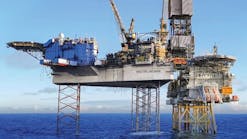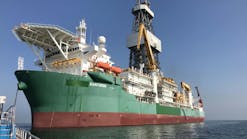Mariner Energy saves time, money with new approach to tree installation
Jennifer Pallanich Hull
Gulf of Mexico Editor
Mariner Energy shrugged off the "it's- always-been-done-that-way" men- tality and saved millions by using a monohull vessel for subsea tree installation and P&A operations in the Gulf of Mexico.
Building on existing technology, Mariner deployed dynamically positioned (DP) monohull multi-service vessels (MSVs) to reduce the cost of work traditionally performed by semisubmersible drilling rigs or field service vessels. In 2003, Mariner installed a horizontal subsea tree on an existing Ochre field wellhead using the MSV's crane with no heave compensation or guidelines and P&A'd three subsea wells with horizontal trees with monohull MSVs in deepwater.
Mariner believes the landing of a subsea tree on a wellhead with a monohull MSV without heave compensation or guidelines set a precedent in the GoM. The P&A of subsea wells with horizontal trees using a monohull MSV is also believed to be the first in the GoM.
Bill Fisher, the drilling and completions manager at Mariner, said the independent took the MSV approach to achieve an economic edge.
"We have to be profitable with the things the majors don't want," Fisher said. "There are levels of innovation that can occur to make things more profitable."
The innovations Mariner uses have made otherwise unprofitable fields commercial.
"It truly is a marginal field," said Richard Weser, production manager at Mariner, about the Ochre field. "This was a skinny project U The challenge was to get this done and actually make money with it."
He said the Houston-based independent found a cost-effective way to develop the field: "We decided to try doing this entire project with used equipment."
Ochre tree with running tool and ROV panel installed on deck of Midnight Wrangler.
null
The appeal of the dynamically positioned monoholl MSV is tied to its lower mobilization costs and lack of mooring and risers, Weser said.
Landing trees
A monohull MSV installed and tested the horizontal subsea tree on a wellhead at the Ochre field on Mississippi Canyon block 66 before a conventional drilling rig arrived for completion activities. The approach took the tree installation off the critical path, saved rig time, decreased weather exposure, and permitted the use of a less expensive, second-generation drilling rig because it did not need the crane capacity to handle the tree.
In August 2003, the Torch Offshore MSV Midnight Wrangler landed the Cameron second-generation Horizontal SpoolTree and installed it on an FMC 10K wellhead in 1,144 ft of water. The 16.6 ft x 16.3 ft subsea tree with the tree running tool, subsea control pod, and bore protector weighed 72,000 lb. Originally placed in service in 1998, it was recovered in the Dulcimer II P&A in April 2003 and refurbished in roughly three months.
The installation required less than six hours on location, rather than the typical 12-24 hours of rig time from a drilling rig to install and lock the subsea tree on the wellhead and seal-test the gasket, Mariner said.
The general procedure, including vessel DP trials and ROV tests, started with a systems integration test. The tree and running tools were then loaded on the MSV, and the tree running tool was installed and locked on the tree. The tree was sea-fastened on the MSV deck, and the MSV moved to location. Following DP checks, the well was located. The ROV briefly surveyed the area and removed the debris cap from the wellhead before gasket preparation and inspecting the wellhead. The vessel moved to position 100 ft away from well, and the lock on the tree running tool was verified. The super winch crane splashed the tree and followed by coordinating the lowering of the tree with vessel movement so that the tree was near the well on reaching depth.
The ROV monitored this procedure and guided the tree over the wellhead before it was slowly lowered onto the wellhead. The tree was oriented to the desired heading and locked to the wellhead before the gasket test was performed. The ROV released the tree running tool, which was recovered at the surface. The debris cap was reset on the subsea tree, and the ROV confirmed and recorded the position of tree valves. The MSV was released.
Mariner said it gave the MSV contractor freedom to choose the operating window based on schedule and weather, so conditions were excellent for the tree deployment with calm winds and seas less than 2 ft.
Based on the amount of observed tree movement, it should be possible to safely deploy a tree in seas up to 5 ft with the Midnight Wrangler, the independent said.
Vessel size provides stability and minimizes heave transferred to the load. Using the crane's super winch eliminated the need for a subsea winch transfer, enabling installation completion in less than six hours. The subsea winch movements were smooth and with sufficient fine adjustment required to land the tree on the wellhead without damage to the gasket and gasket prep.
While loading out the tree, the crane slacked off on the load and one of the wire slings in the rigging lay across some of the exposed control tubing. To correct this, a "crash bar" was fabricated to protect the tubing. In the future, this tubing should be run in more-protected areas to avoid this exposure, Mariner said.
For the Ochre project, running the tree from an MSV saved roughly $100,000 by eliminating rig time associated with lifting and running the tree. Mariner and field partner Stone Energy saved an additional $200,000 by choosing a less-expensive drilling rig. The estimated savings was $300,000 on a $4 million completion budget.
While this trial run on the Ochre deepwater project saved money, the real payoff will come when Mariner undertakes its Swordfish project in 4,700 ft of water in March 2004, when two wells will be drilled and three wells completed. Wet parking of subsea trees on the sea floor is expected to save up to four days of rig time on each of the three wells. With the higher rig spread rates, the savings could reach $1.7 million.
While conditions may be unfavorable for installing trees from MSVs in the North Sea without heave compensation, there are plenty of days when this operation can be conducted in Gulf of Mexico, West Africa, and other areas, the company believes.
P&A of subsea wells
The US Mineral Management Service, which regulates decommissioning activities on the outer continental shelf, generally requires wells to be permanently P&A'd within one year after a mineral lease ends.
The MMS requires removal of well casings below the mud line for wells in water depths less than 2,625 ft. The most cost-effective means has been severing the casing with explosives, which is still being done in shallow water. With the moratorium on the use of explosives in water depths exceeding 640 ft, operators must now use a more weather-sensitive mechanical means to cut and remove casings and wellheads. The additional cost of mechanical cutting is an estimated $300,000 to $500,000 for each well in a multi-well campaign.
While determining project sanction economics, it is not uncommon for deepwater operators to estimate future P&A obligations at $4 million to $5 million per subsea well when performed by semisubmersible drilling rigs or semisubmersible field service vessels. The P&A costs for Mariner's most-recent three-well campaign using a monohull MSV – Mustique II, Dulcimer II, and Apia in 800 ft to 1,200 ft of water – averaged $1.8 million per well, well under the cost quoted to conduct the operation from a moored second-generation drilling rig.
Going the MSV route with lower P&A costs, Weser said, will allow Mariner to qualify more projects for sanction. Reducing long-term financial obligations frees funds for development in addition to improving the company's balance sheet, Weser said.
Oceaneering's Ocean Intervention II, a 253-ft conventional monohull MSV featuring DP-2 station-keeping, performed the P&A operations for Mariner. P&A activities at each well generally began with killing the well and pumping the primary abandonment plug via the production hub. This requires bleeding down the flowline, removing the jumper from the production hub on the subsea tree, and connecting coiled tubing to the production hub. Installing an intervention workover control system establishes control of the subsea tree and opens the SCSSV.
Pumping kill-weight brine into the wellbore and perforations via the production hub kills the well and confirms the feasibility of injection into the formation. The next steps are pumping a specific volume of cement via the production hub and displacing the cement plug with brine. The subsea tree wing valves close to maintain and monitor squeeze pressure. Once the cement sets and pressure bleeds off, a 1,000-psig hydro-test is applied to test the cement plug.
Tree running tool with ROV panel (left) and Apia subsea tree (right) on deck of Oceaneering's Ocean Intervention II.
null
The next portion of the procedure required gaining access to the wellbore, recovering the debris cap, and inspecting the top of the subsea tree with the ROV. Pressure under the internal tree cap was checked and bled off. A tubing hanger running tool on wire retrieved the internal tree cap. The Smoke Stack Guide ensured proper alignment on the tree. Next, a subsea intervention lubricator system with dual circulating lines was installed on the subsea tree to maintain well control while establishing communication to the annulus and tubing. The tubing hanger plug was pulled.
The third series of steps involved cutting and retrieving the tubing hanger and production tubing and setting additional plugs. The tubing was cut below the surface-controlled subsurface safety valve with wireline-conveyed chemical cutter. The tubing hanger, production tubing, and valve were released and retrieved with a tubing hanger retrieving tool operated via the ROV and run on wire rope. The casings were perforated to check for pressure in the well annuli with plugs set as necessary. A 150-ft surface cement plug was set, starting 300 ft below the mud line.
Finally, the subsea tree was retrieved for refurbishment and re-use. The well casings were cut, and the wellhead was retrieved. The well casing was cut below the mud line, and the wellhead was salvaged.
The Ocean Intervention II MSV later returned to the field to sever well casings below the mud line and recover the wellheads and casing stumps.
The P&A of the three wells using a monohull MSV realized a cost savings of roughly 40% compared to use of a moored semisubmersible drilling rig. Both cases include cutting the casing stumps using a mechanical cutter.
A moored second-generation semisubmersible drilling rig under a turnkey contract for three wells had an estimated cost of $8.4 million, or $2.8 million per well. A substantial portion of that amount was mobilization costs, and without a multi-well campaign, the cost to P&A a single well with a drilling rig approaches $3.5 million. The lump sump turnkey contract to P&A three wells from an MSV was $5.4 million and was estimated to require roughly 20 days of field activity at $1.8 million per well.
"Innovation has to be combined with cost containment and risk management to be successful," Weser said.







